Before I shut it down for a few days, we’ve got your Takeaways …
I get to cover a lot of really outstanding people in my job. Which, honestly, is one of the first things I’d tell you I took from reporting on a very scary Wednesday in Kansas City.
Unfortunately, sometimes, it takes a situation like this to remember that. And after the Super Bowl parade shootings at Union Station, as the Chiefs celebrated their third championship in five years, having those types of people around provided an indelible silver lining after gunshots marred what had been, in the words of one team front-office man, “about as perfect a day as you can get.”
With every person I talked to over the last few days, I’d stumble into another story.
It was team president Mark Donovan whose steady hand kept folks calm in a storm of uncertainty. Donovan was in one of the first groups ushered to the buses—when things went haywire, some Chiefs people made it there, others were holed up in the train station—and helped to tell people in transit to find a bus to get on, with those being the safest places. He also helped direct heads of departments to get ahold of their people and established a line of communication with the authorities.
There was Anne Scharf, VP of community impact and civic affairs, who rather than running to the buses, came to the aid of one personnel man and his wife, who’d been separated from their oldest son. Scharf stayed out, joined the dad in the search and eventually found the kid and got him back to his family.
Then there were the players. On Wednesday, on social media, I told the story of Trey Smith, who saw the distraught son of a Chiefs exec, took the WWE title belt to him, gave it to him and sat and talked with him until he calmed down.
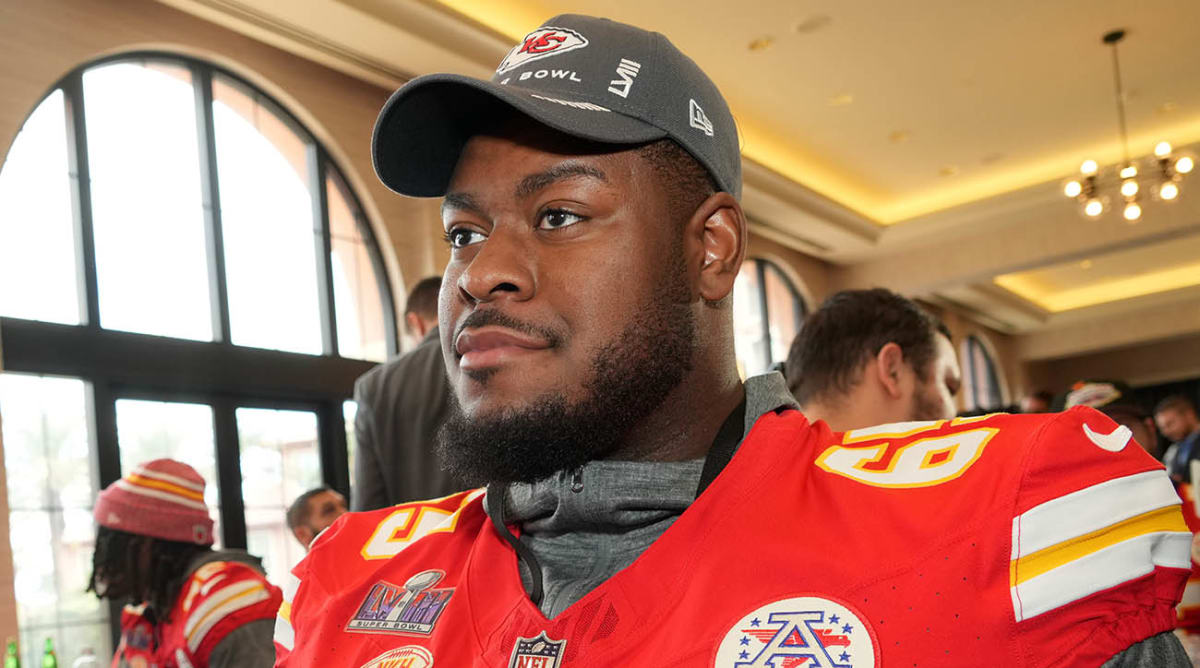
Kirby Lee/USA TODAY Sports
That was hardly the only story that resonated with everyone.
There was long snapper James Winchester, hurrying people into a closet, securing the area and settling people in to wait. “It was like he had military training in it,” said one observer. There was defensive tackle Mike Pennel, who was helping lead a group to the buses—a group that would watch a door open and see cops with guns drawn chasing a shooter—then quickly reset and got them into a secure, windowless hallway. There was Blaine Gabbert, leaving the security of the bus to go help others get there. There was a local news story out there, too, explaining how Clyde Edwards-Helaire protected a teenager separated from his dad.
There was a whole lot of humanity on display.
Then, there was the other side of it. Another story I’d heard came from a coach with two elementary-school-aged kids. When people started running and turning over tables and diving for cover, the older of his kids said, “Dad, walk fast but don’t run.” As they made it to a hallway, his younger kid reminded him to lock the door behind him.
That, to me, was chilling.
I was reminded by someone soon after all this happened how these players, mostly in their 20s, are part of the first generation to grow up with all of this as a part of their lives. I was a freshman in college when Columbine happened. Patrick Mahomes was 3. Trey Smith wasn’t born yet. Pennel was a 7-year-old in nearby Aurora, Colo. Sadly, we, as a country, have had to teach all these kids what to do in these situations. The kids younger than them know, too.
This is because, of course, kids now go through active-shooter drills the same way my generation went through fire drills, or a kid in Kansas City might go through a tornado drill. How we got there is obvious—through incidents at schools, churches, preschools (for Christ’s sake), movie theaters, concerts and, now, a freaking Super Bowl parade.
I don’t want to get political here. But it sure seems to me like the lawmakers, on both sides of the aisle, have conflated having a hunting rifle or a handgun in your house to protect your family with walking around on a city street armed for combat or owning a weapon of war. That they can’t find a middle ground on the issue because of where their money is coming from is an indictment on the character of every last one of them.
I love that the Chiefs showed their own character in such an adverse situation last week, the type of situation that’s uniquely of this generation in America.
I just wish, on a day like that, it wasn’t necessary.
Football probably seems pretty trivial to Chiefs folks right now, but Kansas City had a good week in that department as well. The team was able to get defensive coordinator Steve Spagnuolo, special teams coach Dave Toub and defensive line coach Joe Cullen signed to new contracts over the last couple of weeks—and, beyond just the presence of Patrick Mahomes (obviously, the biggest factor), Kansas City’s ability to establish such continuity is another reason to think the Chiefs may just be getting started.
The Chiefs’ three coordinators—Spagnuolo, Toub and offensive coordinator Matt Nagy—have a staggering 39 years of experience, between Philadelphia and Kansas City, working for Andy Reid. Spagnuolo and Nagy have already been head coaches, and Toub’s been up for jobs in the past, but it’s reasonable to think that all three could be around a while helping the head coach add to a trophy case that’s busting at the seams.
And the team’s ability to retain someone like Cullen speaks to the advantage the Chiefs have now, one that the Patriots used to wield in building their dynasty behind another transcendent quarterback.
Cullen was actually offered the Michigan defensive coordinator job a couple weeks back. He’d hit it off with the Wolverines’ new head coach, Sherrone Moore, and really appreciated getting—and considered taking—the opportunity the defending national champions put in front of him. But in the end, the situation he had in Kansas City was too good to walk away from, as much as he liked Moore, and as much as he’d like to be a coordinator again.
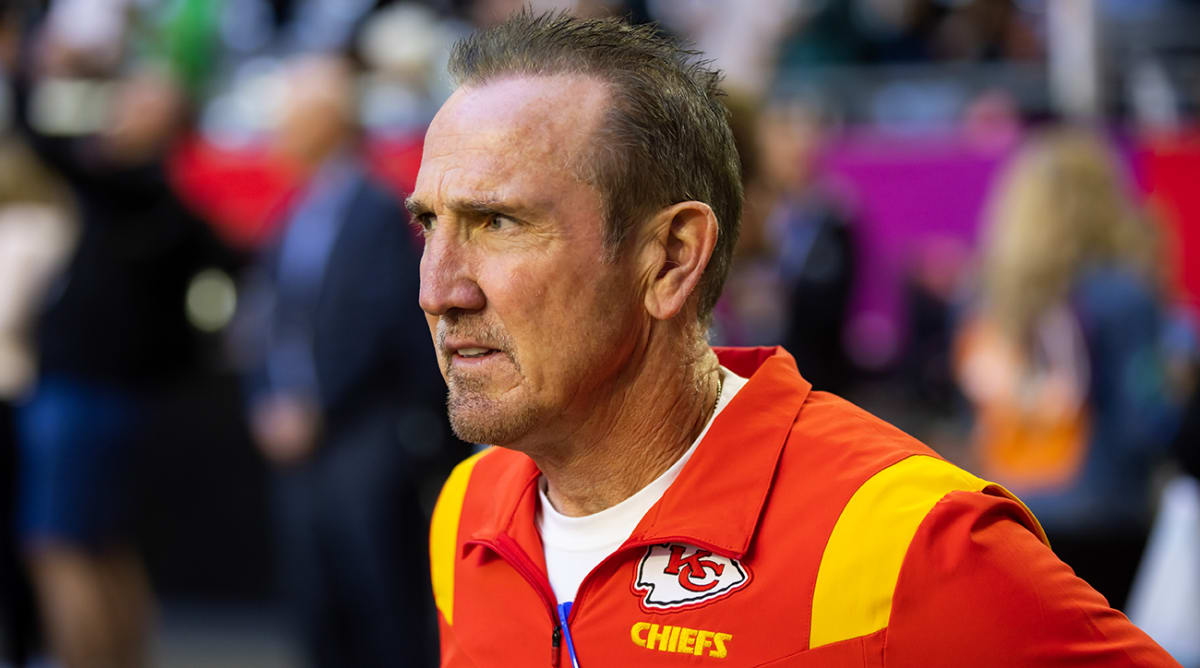
Mark J. Rebilas / USA TODAY Sports
So Cullen, one of the NFL’s very best at what he does, is staying with a new contract, and staying in the way New England was once able to hold on to guys that had a shot at taking steps forward career-wise elsewhere. And while Cullen was a relatively recent addition to the staff, there are others (Andy Heck, Joe Bleymaier, Dave Melvin) who predate Mahomes in Kansas City and have stuck around, and some that came with Spagnuolo in 2019 (Dave Merritt, Brendan Daly) that are still on staff.
Of course, I’m not telling anyone all this is as big a reason the Chiefs are winning like this as, say, Mahomes is. But it certainly doesn’t hurt.
If the Bears, Commanders or Patriots are willing to deal out of the Top 3, there will be a hot market for their picks. The reason why, as you’d expect, is the makeup of the quarterback class. USC’s Caleb Williams, North Carolina’s Drake Maye and LSU’s Jayden Daniels are considered a cut above the second tier (made up of Michigan’s J.J. McCarthy, Oregon’s Bo Nix and Washington’s Michael Penix Jr.) at this early juncture. Which increases the chances QBs go 1-2-3, and the value of picks in that range.
There are a couple of pieces of history to examine here that can serve as your guide.
The first is the rate at which Top 3 picks are actually moved. In the last 10 drafts, seven teams traded up into, or within, the Top 3. Six of the seven moves were for quarterbacks. The seventh was the Texans’ trade up last year for Will Anderson Jr., and a quarterback was part of that equation, since Houston had just taken C.J. Stroud with the second overall pick. So in this era, teams really only trade into that range if it involves landing a young, potential franchise quarterback.
The second piece is the premium paid for such high picks that result in teams landing such quarterbacks of the future. Five of the seven involved a first-rounder the following year. In one of the two that didn’t, the Colts got two current-year second-round picks (37th and 49th overall), plus a second-rounder the following year from the Jets, while only dropping three spots in the draft order. In the other, the Niners got two thirds (one current year, one the following year) and a fourth from the Bears for dropping one spot.
So that tells you the moves up would have to be for a quarterback, and they’d be expensive for the team moving up.
Then, you can look at the teams that might be in play to move up—and you can easily come up with scenarios where the teams picking 6 (Giants), 7 (Titans), 8 (Falcons), 11 (Vikings), 12 (Broncos) and 13 (Raiders) could have an interest in making that move. Which tells you there very well should be a market for one of the first three picks, and even moreso if, say. only one of the top three teams is willing to move its pick.
Now, my guess would be the Bears stay where they are and take Williams at 1. Washington, then, would probably have the ability to move its pick, though my guess would be the Commanders probably stick and take a quarterback, too. And they could do that soon, in selling another team the choice between Maye and Daniels. It’s a little trickier for New England, given that, if you try to move the pick before draft day, then the trading team would have to be comfortable with all three quarterbacks. But Miami pulled it off in 2021.
Regardless, those three picks have very real, premium value right now. And my guess would be there’ll be at least some preliminary trade talks on them, whether it’s coming from the teams holding the picks or teams looking to get them, in Indianapolis next week.
I don’t know where Jimmy Garoppolo’s career goes from here. News of the 32-year-old failing a PED test broke this week. He’ll be suspended for two games. The positive test also voids an $11.25 million guarantee on the roster bonus he’s due in March, making it easier for Vegas to do what it was already planning to—which is cut the ex-Niner and Patriot.
So what’s next?
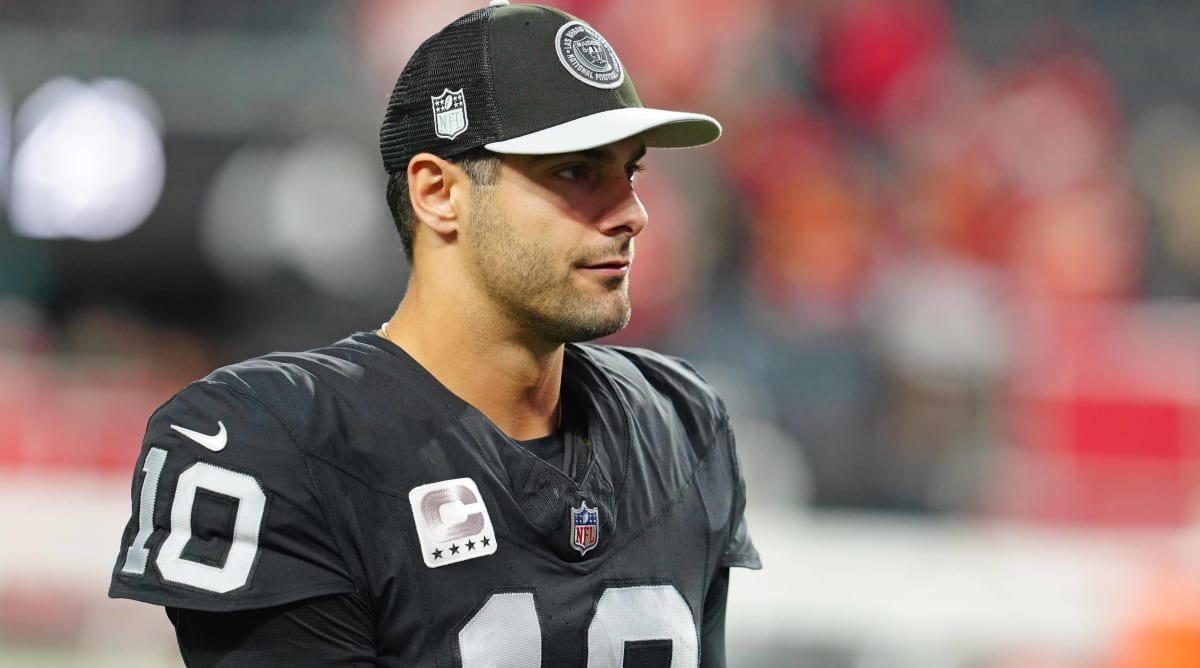
Stephen R. Sylvanie/USA Today sports
That’s pretty tough to ascertain. Garoppolo had a reputation for being aloof in San Francisco, which would drive detail-oriented coach Kyle Shanahan nuts, particularly when, at points of the offseason, the Niners would have trouble getting ahold of him. Some of those problems carried over to Vegas, where a group that knew him, led by GM Dave Ziegler and coach Josh McDaniels, had hoped he’d grow out of some of those tendencies.
Then, there’s the injury issue. Garoppolo started games in eight of his 10 NFL seasons. In six of those eight seasons, he lost games due to injury. In two of the six, his injuries were season-ending. And beyond the big ones (knee, foot), there always seems to be something going on with Garoppolo from a health standpoint.
Add it up, and that’s why I’m not sure he really fits anywhere as a backup. You need your backup to be locked in, and you need him to be healthy—and there’d be concerns, again, fair or not, based on his reputation and history in both those areas.
That leaves maybe a bridge-quarterback situation or coming in like Jay Cutler or Joe Flacco did, as a quick-fix starter in an emergency, as the paths for Garoppolo back into playing in 2024. And after he seemed content to play out the string in the shadows last year, some wonder if he’ll really want to do that or if, after 10 years in the NFL, he’s good with what he’s accomplished.
As it is, Garoppolo’s had a pretty interesting run, first as a pivotal figure in the twilight of the Patriots dynasty, where he’d been positioned as Brady’s heir apparent, and then as the guy that led the Niners to a Super Bowl at the start of the Shanahan Era, only to become someone San Francisco fervently looked to replace.
If this is the final chapter for Garoppolo, the story he’s written sure hasn’t been boring.
The viability of Kirk Cousins’s impending free agency is highlighted by situations like Garoppolo’s. It’s fun to think of Baker Mayfield switching teams, or of Garoppolo reviving his career somewhere. But the reality is this—Cousins stands as the most viable veteran option for quarterback-hungry teams, even at 36, even coming off a torn Achilles.
Because of some creative timing in his contract (his current deal voids after the deadline to tag a player is passed), Cousins can’t be franchised by the Vikings, so all he has to do to become available to the other 31 teams is, well, do nothing contractually until mid-March.
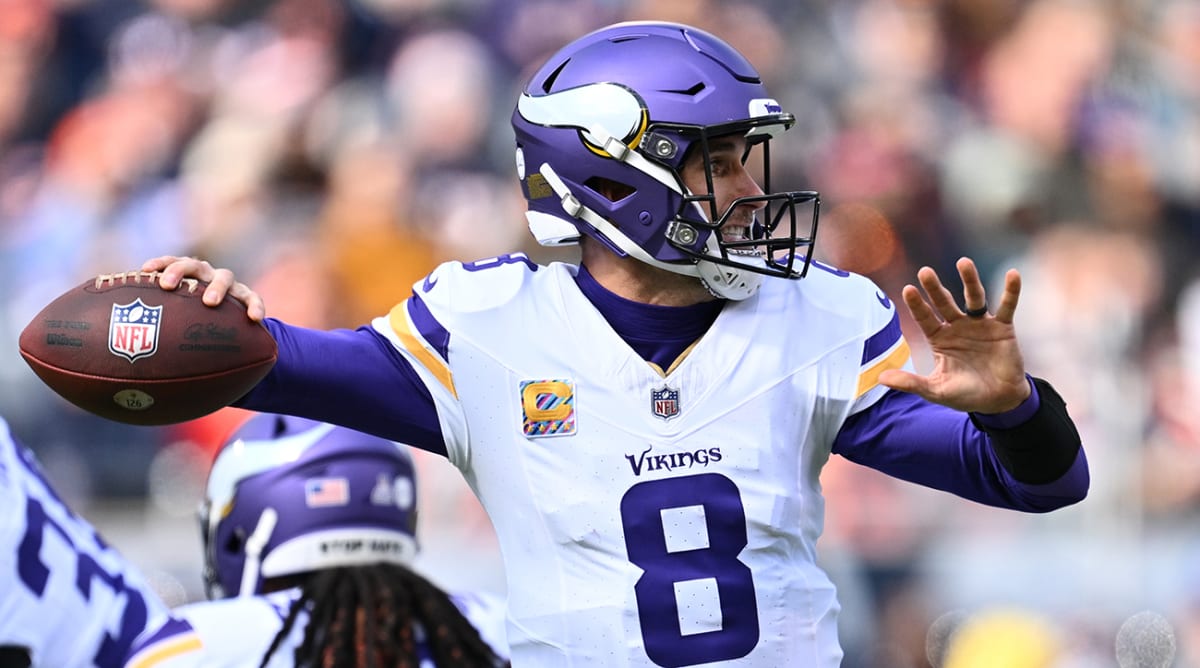
Jamie Sabau/USA TODAY Sports
At this point, it makes the most sense for him to do that. The current Minnesota brass, now going into its third season, really likes Cousins, but it’s also been made clear that they’re not going to go contractually where the previous regime did twice, and give Cousins a fully guaranteed deal. Absent that, Cousins is now in position to hit the market like he did six years ago, this time older and, of course, more injured.
That said, the success he’s had in the Sean McVay/Kyle Shanahan offense, both early in his career with Kyle in Washington, and over the last two years under Kevin O’Connell in Minnesota (and before that with Kevin Stefanski and Gary and Klint Kubiak) would ostensibly make him an attractive candidate to join new offensive coordinators in Las Vegas (Luke Getsy) or Atlanta (Zac Robinson), who have strong ties to that coaching family.
What sort of price Cousins will be able to command is another question. Derek Carr and Garoppolo did pretty well on the B-level market last year, as did Geno Smith, so something like $30 million would seem to be attainable. Is $40 million or $45 million per in reach? That’s a good question, as is how far the Vikings would be willing to go to keep Cousins.
For what it’s worth, the Vikings did touch base with Cousins’ camp last week, as they got their pre-combine meetings going, so the lines of communication are open. More clarity could come in Indianapolis next week.
Speaking of those teams, this is right around the time the Raiders and Falcons will start to marry their personnel departments to their coaching staffs. Remember, the GMs in those two places (Tom Telesco and Terry Fontenot, respectively) don’t have a lot of background with the coaches (Antonio Pierce and Raheem Morris) that they’ll be working with. So in the coming weeks, those coaches will be presenting to the scouts, as to what they want stylistically at every position, and prototypes will be put together.
With that in mind, it’s hard to pinpoint exactly where those two teams are going until then.
Both, certainly, could be trade-up candidates in the draft. Last year, the Raiders fished around pretty extensively on the idea of moving up, and engaged in talks to go up to 1 or 2 (eventually deciding it was too pricey, after trading a 1 and 2 for Davante Adams the year before)—and it’s fair to wonder if seeing what Stroud did for Houston has an effect on what Mark Davis is looking for from his football folks. Atlanta, meanwhile, has a balanced roster that should give them the flexibility to flip picks for a move up.
Going to a vet like Cousins, again, would be another interesting route for both teams. But after the year those two had at the position in 2023, it’d be hard to see either being content to just tread water at quarterback again.
Either way, whatever the plan is for those teams, it should come together soon.
Such is the case with the Bears and Justin Fields—with the team having gotten a little insight into what his trade value may be. Chicago staffers got inquiries from other teams on Fields in Mobile. And while the Bears haven’t shopped Fields, those conversations did allow the team to start to gauge the 2021 first-rounder’s worth out there on the market.
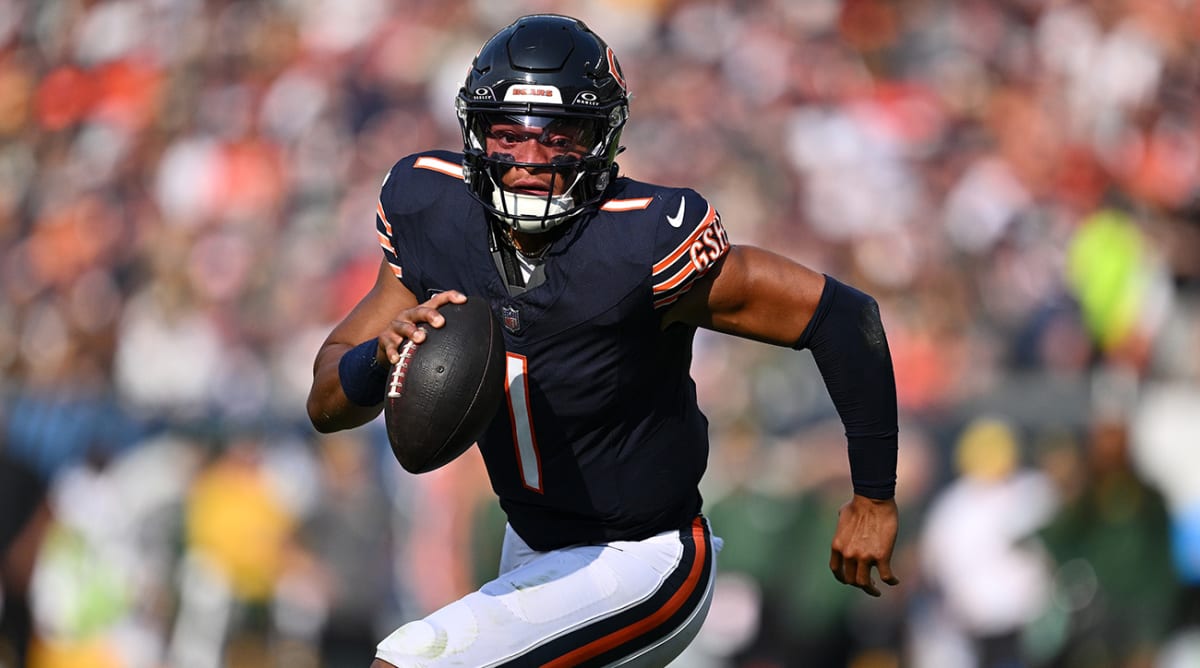
Jamie Sabau/USA TODAY Sports
The Bears are meeting over the next couple weeks to finalize plans at quarterback, with the expectation that they’ll have the plan in place in Indianapolis next week.
Looking at how Chicago handled last year can be instructive. Bears GM Ryan Poles went to the combine in 2023 holding the first overall pick, knowing he’d try to move it but without having done much in the way of shopping it. Less than two weeks later, he moved it, and did so for two reasons. One, the Panthers met the premium that Chicago sought for trading the pick that early. Two, it involved a veteran player (DJ Moore) and, for cap and need purposes, Poles wanted to have clarity in what he’d be working with in free agency.
This time around, the likelihood is the principle in such a trade would be a veteran player, and, naturally, more teams have a quarterback need now than will be the case a month from now, so it makes sense—again, if you’re going to trade Fields—to do it soon.
Now, the Bears love Fields as a person, and really like him as a player, so I would say that whatever they do in the next few weeks will be with respect to a guy who gave them a lot, physically and otherwise, over the last three years. But I think the reality, for Chicago, will be that the talent of Caleb Williams plus the chance to reset the quarterback-on-a-rookie-contract clock will be too much for Chicago to pass on. We’ll see.
What Athletes First and Rosenhaus Sports did over the last few weeks is pretty interesting. Our old friend Kalyn Kahler had the news late last week that Athletes First (one of the leading player agencies, if not the leading player agency, in the sport) had notified teams it was advising its clients not to submit to the pre-draft cognitive testing (most prominently the S2 test) that teams have come to rely on in recent years. Soon thereafter, Pro Football Talk reported that Rosenhaus Sports had done the same.
So on Sunday morning, I reached out to Drew Rosenhaus to talk about it.
He told me he sent the letter to all 32 teams on Jan. 27, just ahead of Senior Bowl week. And while he has, in the aftermath, heard from some of those who administer the tests, he said that he hasn’t heard, or gotten any pushback, from any of the 32 teams, which could be taken as tacit admission from them that such tests aren’t that important to the process.
As for Rosenhaus’s decision, he said it was made after consulting with clients who’d gone through the testing in recent years, and with his veteran staff (Jason Rosenhaus, Robert Bailey, Ryan Matha, etc.). Some of what happened last year—Athletes First client Stroud obviously figured prominently in that—simply served as a tipping point.
“In just speaking with people around the league, I have a lot of respect for doing whatever we can to help our clients get drafted and get drafted as high as they can,” he said. “But in this particular case, I think a lot of these tests actually work against our clients. I don’t want to point any fingers at anyone or hurt anyone’s feelings, the people that put these tests together, and I personally don’t want to speak for the teams, but I would like for our clients’ character and intelligence and football IQ to be measured in individual meetings and interviews.
“And I think that’s fair. We’re open to that, and as much as the teams would like to do that at the all-star games, at the combine, at pro days and at Top 30 visits, we’re willing to do that.”
Rosenhaus also said that, as part of this, he’d also advise his clients to pass on taking the Wonderlic test at the combine—Alabama OT J.C. Latham, Georgia S Javon Bullard and Michigan RB Blake Corum are among the nine clients he has that were invited to Indy.
He added that, “I really respect what Athletes First is doing,” and said he knows other high-profile agencies are thinking of following suit, joining A1 and RSR. And if that’s the case, then, well, there could be very real change coming in a space that’s been the subject of a lot of arguments before the draft for a couple decades now.
The Seahawks did the absolute right thing in going forward with Geno Smith. Seattle has something, in Smith, that’s enviable in today’s NFL—a combination of cost certainty and flexibility at the quarterback position.
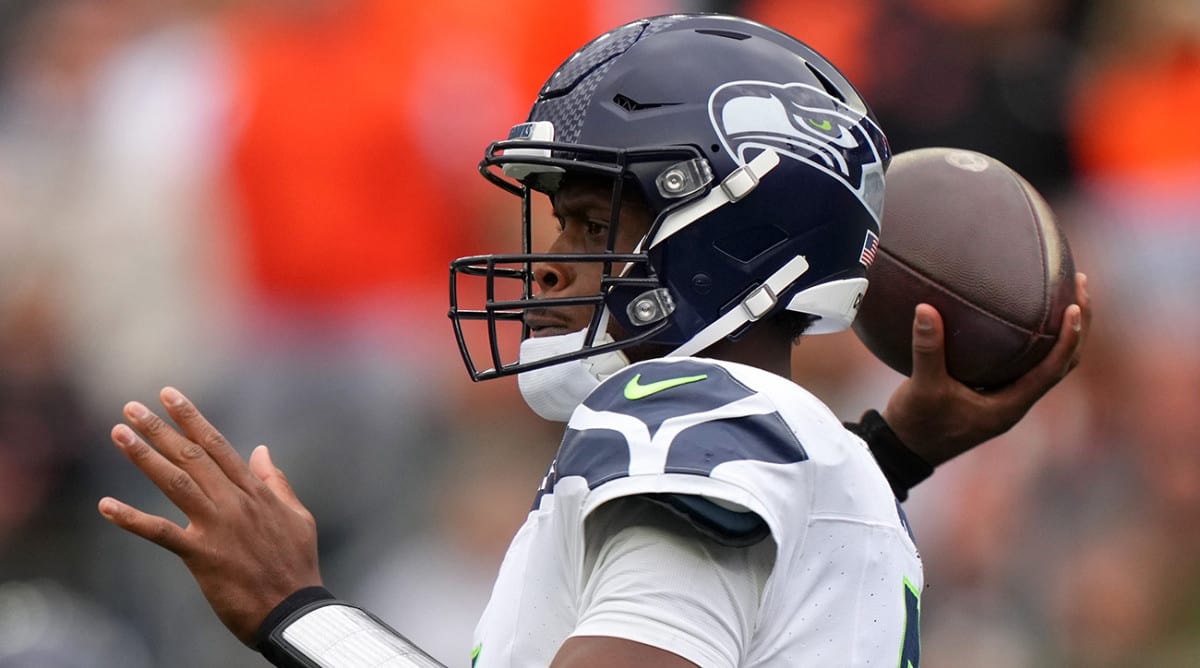
Kareem Elgazzar/USA TODAY Sports
Smith doesn’t turn 34 until the fall, and steadied the position for the team through its 2022 divorce with Russell Wilson. He’s thrown for 7,906 yards, 50 touchdowns and 20 picks over the last two years—and kept the team in contention throughout. He’s also the right kind of guy for the transition, as someone who’s been through a lot, and can help new coach Mike Macdonald bridge the unique culture Pete Carroll left behind to a new way of doing things.
In a lot of ways, I’d view this as what Alex Smith was for Andy Reid in Kansas City. Smith allowed for the Chiefs to take their time in waiting for the right quarterback to come along, and to go all-in on, while they built the team around the position. So by the time they’d identified Mahomes as that guy, they had an incredible support system and program in place to help him make the transition from college to pro.
Smith’s base pay for next year is $22.5 million, and that jumps to $25 million in 2025, which is a pretty reasonable rate given what the Seahawks are getting from him.
We’re in that in-between week. So I’m about go dark for a few days to take my kids skiing (I’ll be back next Monday, with the combine starting, and a full MMQB to preview it). First, though, here are our quick-hitting takeaways to wrap 2023 and look ahead to 2024 …
• If you want to see the moment Steve Wilks lost Kyle Shanahan, go to the timeout the head coach called with 2:48 left in overtime of the Super Bowl. Two plays prior, Wilks rushed seven and played his DBs nearly 10 yards off the ball on third-and-6, essentially giving the Chiefs an easy first down. They were in a similar look before the timeout, and Shanahan was clearly frustrated, and it wasn’t the only time (it was visible, too, with the scheme issues on Mahomes’s two big runs, the latter of which came on fourth down in overtime).
• I also believe Wilks was on shaky ground going into the game. Fair or not, there was some belief in that organization that a stacked defense hadn’t reached its potential in the regular season, which was only validated in narrow playoff wins over Green Bay and Detroit.
• New University of Washington head coach Jedd Fisch now has the sons of Bill Belichick, Pete Carroll, Jack Del Rio and John Lynch on his staff—as part of his stated effort to make the Huskies the “33rd team.” Obviously, it’ll be a benefit to the players having those dads stopping by and hanging around.
• I will be interested to hear the discussion on whether or not to implement the playoff OT rules in the regular season. One strike against the idea that won’t be discussed as much publicly, but is relevant to the players, is how that would stand to add snaps to an already really long season, and put more miles on more bodies.
• I hope we can all stop pretending that Russell Wilson is staying in Denver. This is one case where I think reading the real estate news actually does mean something.
• The Saints’ addition of Andrew Janocko as quarterbacks coach has actually been firmed up for a few weeks now—and I think it’ll prove to be an underrated one. He’s a promising young coach who could become important if Klint Kubiak’s offense takes off, and Kubiak gets a shot to be a head coach down the line.
• I really like the idea of Fields in Pittsburgh under Arthur Smith. That said, it’s at least worth noting that Smith, in his first draft in Atlanta, did pass on the ex-Ohio State star.
• If the Bengals go through with tagging Tee Higgins, that’ll be interesting. Do they pay him, knowing whatever they give him sets the floor for Ja’Marr Chase? Or do they let him go, knowing they could land an affordable replacement in a deep draft for receivers with the capital coming back, and then focus on locking up Chase? It’s an interesting question.
• Good for A.J. McCarron going back to play with the St. Louis Battlehawks of the new UFL (which merged the XFL and USFL), after finishing last year with the Bengals. That’s a guy, at 33 years old, who just wants to play.
• Our prayers are with Class of 2024 Pro Football Hall of Famer Steve McMichael and his family. If you missed it, seek out what Rex Ryan said about him on ESPN’s pregame show on Super Bowl Sunday. You’ll see how much he meant to the legendary 1985 Bears.







